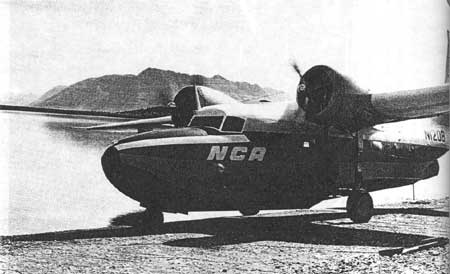- Grumman Mallard
infobox Aircraft
name = Grumman Mallard
caption = Grumman G-73 Mallard
type = Amphibious airliner
manufacturer =Grumman
designer =
first flight =30 April 1946
introduced =
retired =
status = In service
primary user =Chalk's Ocean Airways
more users =
produced = 1946-1951
number built = 59
unit cost = $115,000 $4.0 million for turbine powered G-73T
variants with their own articles =The
Grumman G-73 "Mallard" is a large, twin engineamphibious aircraft . Many have been modified by replacing the original Pratt & Whitney Wasp H radial engines with modernturboprop engine s. Manufactured from 1946 to 1951, production ended when Grumman's much larger SA-16 Albatross was introduced.Design and development
Building on the success of the Goose and Widgeon, Grumman Aircraft developed Design 73, the larger "Mallard" for commercial use. Retaining many of the features of the smaller aircraft, such as twin radials, high wings with underwing floats, retractable gear and a large straight tail, the company built 59 Mallards between 1946 and 1951. Unlike the smaller aircraft, the Mallard featured tricycle gear, a stressed skin, two step hull and wingtip fuel tanks.
Operational history
The Mallard prototype first flew on 30 April 1946, with the first production aircraft entering service in September of that year. While the Mallard was designed for regional airline operations with two pilots and ten passengers especially aimed at harbor-based, city-to-city hops on the eastern seaboard, postwar surplus aircraft sales and the availability of smaller airports limited market potential. A number of smaller air carriers did use the Mallard in its intended role, notably Tahiti-Hawaii Airlines and Pacific Western Airlines (Canada). However, most of the 59 Mallards delivered were for corporate use.
The Mallard received a lease in life in the 1970s when a number of airframes were refitted by
Frakes Aviation withPratt & Whitney Canada PT6A turbines and upgraded for 17 passengers, to become "Turbo Mallards." Today, through attrition, only 32 Mallards remain registered in the US. Many of the rest are in use around the globe.A similar program has been undertaken by Paspaley Pearling in combination with
Aero Engineers Australia to re-engine and modernise its Mallard fleet, which are used to support its pearling operations in Northern Australia. The fleet has been extensively rebuilt and also reengined with P&WC PT6As and are currently undergoing a life extension program.Incidents
The type received much attention after a Mallard, operating as
Chalk's Ocean Airways Flight 101 , crashed after takeoff fromMiami on19 December 2005 . Eighteenpassenger s and two crew perished when the right wing separated from thefuselage . The cause of the accident was determined to be cracks and/orcorrosion in thewing spar .Prior to 2005,
Chalk's Ocean Airways had an exemplary safety record operating Mallards for many years betweenFlorida and theBahamas , having never had a passenger fatality since thecompany began operations in 1917.Operators
Civil operators
;AUS
*Paspaley Pearling Co.;flag|Canada|1921
*Pacific Western Airlines ;USA
*Antilles Airboats
*Chalk's Ocean Airways
*Virgin Islands Seaplane Shuttle Military operators
;flag|Egypt|1922
*Royal Egyptian Air Forcepecifications (G-73T)
aircraft specifications
plane or copter?=plane
jet or prop?=prop
ref=
crew=two, pilot and co-pilot
capacity= Up to 17 passengers, but executive configurations are mostly applied.
payload main=
payload alt=
length main= 48 ft 4 in
length alt= 14.7 m
span main= 66 ft 8 in
span alt= 20.3 m
height main= 18 ft 9 in
height alt= 5.7 m
area main=
area alt=
airfoil=
empty weight main=
empty weight alt=
loaded weight main=
loaded weight alt=
useful load main= 5,000 lb
useful load alt= 2,268 kg
max takeoff weight main=
max takeoff weight alt=
more general=engine (prop)=
Pratt & Whitney PT6A-34
type of prop=
number of props=2
power main= 600 hp
power alt= 447 kW
power original=max speed main=
max speed alt=
cruise speed main=
cruise speed alt=
stall speed main=
stall speed alt=
never exceed speed main= 187 Kts
never exceed speed alt=
range main= 1,120 nautical miles
range alt= 2,070 km
ceiling main= FL245
ceiling alt=
climb rate main= 1350 ft/m
climb rate alt=
loading main=
loading alt=
thrust/weight=
power/mass main=
power/mass alt=
more performance=armament=
avionics=ee also
aircontent
related=
*HU-16 Albatross similar aircraft=
*PBY Catalina lists=
*List of flying boats see also=
References
Notes
Bibliography
* Thruelsen, Richard. "The Grumman Story". New York: Praeger Publishers, Inc., 1976. ISBN 0-275-54260-2.
* Winchester, Jim, ed. "Grumman Goose/Mallard." "Biplanes, Triplanes and Seaplanes (The Aviation Factfile)". Rochester, Kent, UK: Grange Books plc, 2004. ISBN 1-84013-641-3.External links
* [http://www.nytimes.com/2005/12/20/national/20plane.html "New York Times' article about Chalk's accident]
* [http://www.amtonline.com/article/article.jsp?id=2493&siteSection=1 "Aircraft Maintenance Technology" article about Chalk's accident]
* [http://www.ntsb.gov/ntsb/brief.asp?ev_id=20060106X00018&key=1 NTSB preliminary report on Chalk's accident DCA06MA010 of 19 December 2005]
* [http://www.nytimes.com/imagepages/2005/12/19/national/19cnd-plane2ready.html Picture of a Chalk's Mallard in Miami in 1996]
* [http://www.answers.com/topic/flying-boat-inc-chalk-s-ocean-airways History of Chalk's Ocean Airways at answers.com]
Wikimedia Foundation. 2010.
